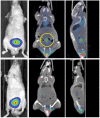Antibody targeting of phosphatidylserine for the detection and immunotherapy of cancer
- PMID: 29417044
- PMCID: PMC5788995
- DOI: 10.2147/ITT.S134834
Antibody targeting of phosphatidylserine for the detection and immunotherapy of cancer
Abstract
Phosphatidylserine (PS) is a negatively charged phospholipid in all eukaryotic cells that is actively sequestered to the inner leaflet of the cell membrane. Exposure of PS on apoptotic cells is a normal physiological process that triggers their rapid removal by phagocytic engulfment under noninflammatory conditions via receptors primarily expressed on immune cells. PS is aberrantly exposed in the tumor microenvironment and contributes to the overall immunosuppressive signals that antagonize the development of local and systemic antitumor immune responses. PS-mediated immunosuppression in the tumor microenvironment is further exacerbated by chemotherapy and radiation treatments that result in increased levels of PS on dying cells and necrotic tissue. Antibodies targeting PS localize to tumors and block PS-mediated immunosuppression. Targeting exposed PS in the tumor microenvironment may be a novel approach to enhance immune responses to cancer.
Keywords: bavituximab; imaging; immunosuppression; immunotherapy; phos-phatidylserine; tumor microenvironment.
Conflict of interest statement
Disclosure XH, JG, JC, and BDF are employees of Peregrine Pharmaceuticals, Inc., Tustin, CA, USA, and receive salary and stock options from the company. OB, RAB, and AJS, University of Texas Southwestern Medical Center, are collaborators of Peregrine and receive research funding from the company. The authors report no other conflicts of interest in this work.
Figures



Similar articles
-
Phosphatidylserine (PS)-targeting chimeric Interferon (IFN) fusion proteins for anti-tumor applications.bioRxiv [Preprint]. 2025 Jan 26:2025.01.24.634764. doi: 10.1101/2025.01.24.634764. bioRxiv. 2025. PMID: 39896467 Free PMC article. Preprint.
-
Development of betabodies: The next generation of phosphatidylserine targeting agents.J Biol Chem. 2024 Sep;300(9):107681. doi: 10.1016/j.jbc.2024.107681. Epub 2024 Aug 17. J Biol Chem. 2024. PMID: 39159812 Free PMC article.
-
Targeting phosphatidylserine for Cancer therapy: prospects and challenges.Theranostics. 2020 Jul 23;10(20):9214-9229. doi: 10.7150/thno.45125. eCollection 2020. Theranostics. 2020. PMID: 32802188 Free PMC article. Review.
-
TIMs, TAMs, and PS- antibody targeting: implications for cancer immunotherapy.Cell Commun Signal. 2020 Feb 22;18(1):29. doi: 10.1186/s12964-020-0521-5. Cell Commun Signal. 2020. PMID: 32087708 Free PMC article. Review.
-
Phosphatidylserine: The Unique Dual-Role Biomarker for Cancer Imaging and Therapy.Cancers (Basel). 2022 May 21;14(10):2536. doi: 10.3390/cancers14102536. Cancers (Basel). 2022. PMID: 35626139 Free PMC article. Review.
Cited by
-
Mobilizing phospholipids on tumor plasma membrane implicates phosphatidylserine externalization blockade for cancer immunotherapy.Cell Rep. 2022 Nov 1;41(5):111582. doi: 10.1016/j.celrep.2022.111582. Cell Rep. 2022. PMID: 36323258 Free PMC article.
-
Combination of a T cell activating therapy and anti-phosphatidylserine enhances anti-tumour immune responses in a HPV16 E7-expressing C3 tumour model.Sci Rep. 2021 Feb 24;11(1):4502. doi: 10.1038/s41598-021-82108-4. Sci Rep. 2021. PMID: 33627686 Free PMC article.
-
Blocking antibody-mediated phosphatidylserine enhances cancer immunotherapy.J Cancer Res Clin Oncol. 2021 Dec;147(12):3639-3651. doi: 10.1007/s00432-021-03792-3. Epub 2021 Sep 9. J Cancer Res Clin Oncol. 2021. PMID: 34499223 Free PMC article. Review.
-
Importance of Efferocytosis in COVID-19 Mortality.Infect Drug Resist. 2022 Mar 10;15:995-1007. doi: 10.2147/IDR.S348639. eCollection 2022. Infect Drug Resist. 2022. PMID: 35299855 Free PMC article. Review.
-
Bilayer Forming Phospholipids as Targets for Cancer Therapy.Int J Mol Sci. 2022 May 9;23(9):5266. doi: 10.3390/ijms23095266. Int J Mol Sci. 2022. PMID: 35563655 Free PMC article. Review.
References
Publication types
LinkOut - more resources
Full Text Sources
Other Literature Sources

